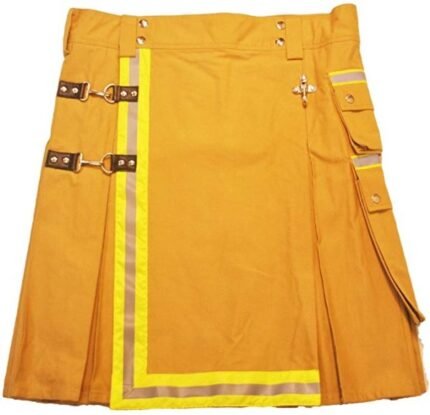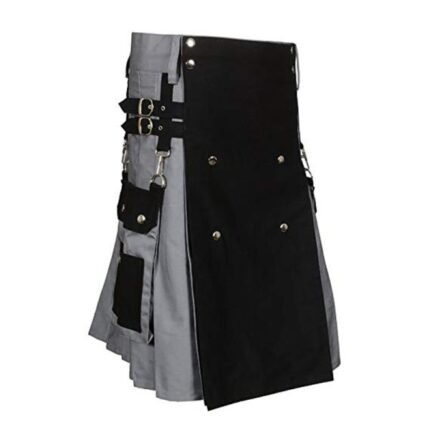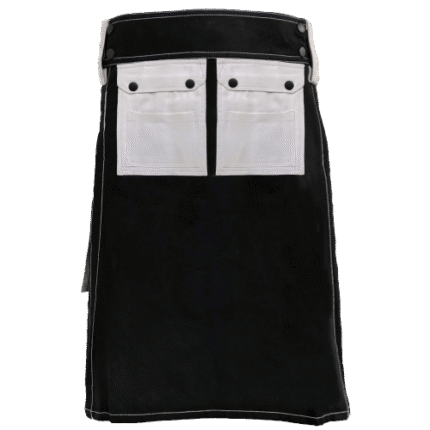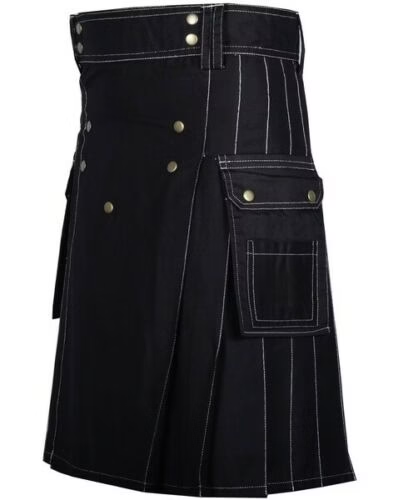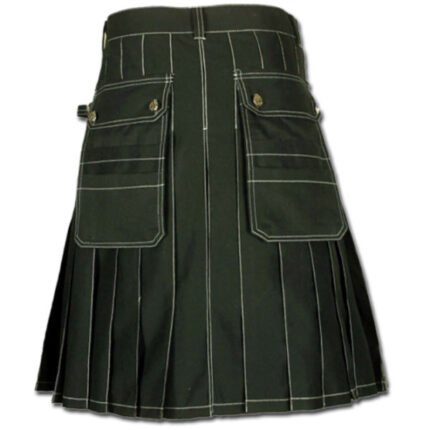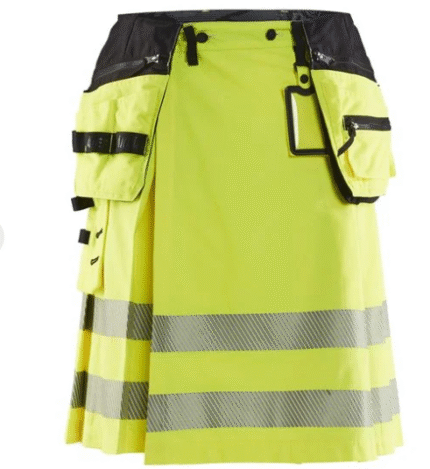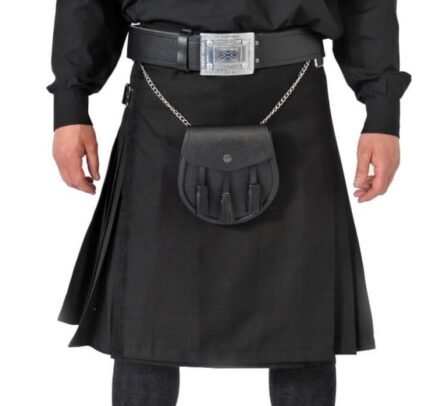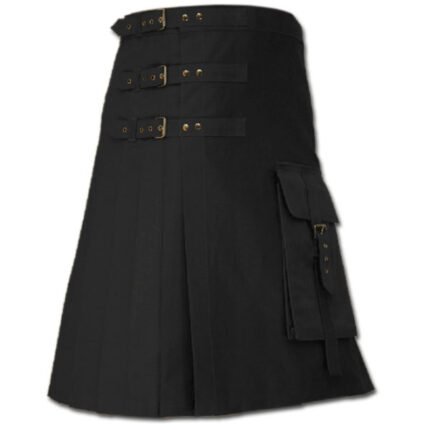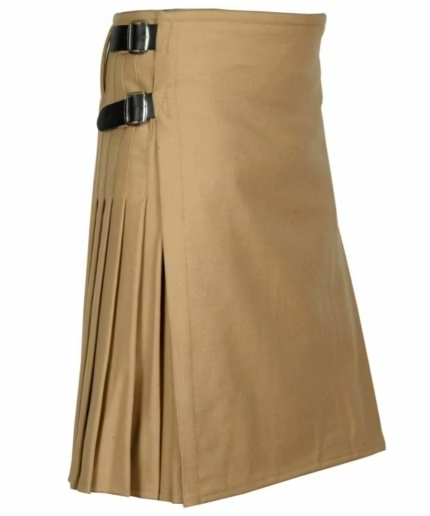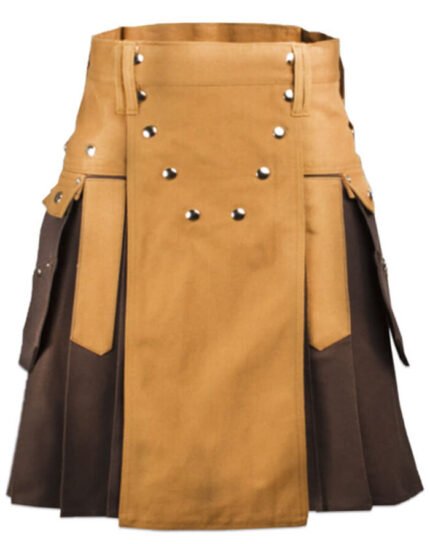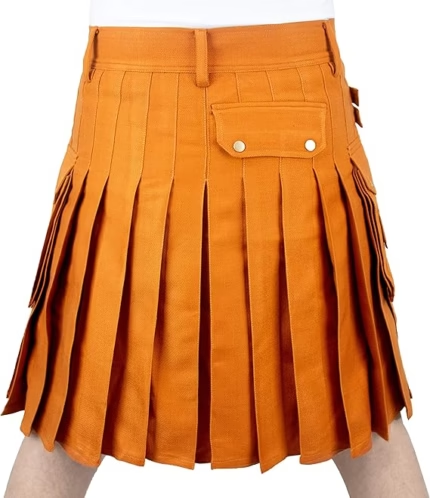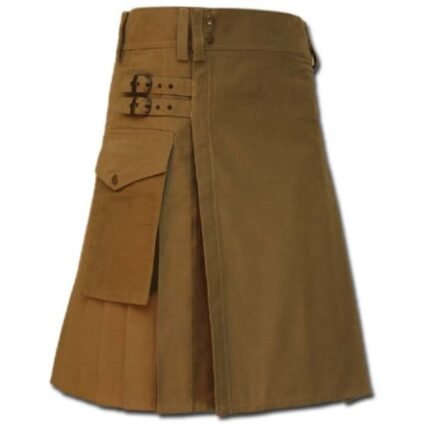Introduction to Scottish Utility Kilts
Scottish utility kilts represent a unique fusion of tradition and modern functionality, captivating wearers with their rich historical significance and versatile design. Originally worn as a garment of choice in the Scottish Highlands, the kilt has evolved dramatically over the centuries. Today, utility kilts have emerged as a practical alternative, not only suitable for casual wear but also functional for various outdoor activities. This article delves into the history, design features, cultural impact, and practical aspects of utility kilts, providing a comprehensive understanding of this distinctive attire.
Historical Significance
The kilt, as we know it today, has its roots in 16th-century Scotland. Initially, it was a long piece of cloth known as the great kilt, which could be draped and fastened in multiple ways. The traditional kilt was often made from wool and featured tartan patterns representing different Scottish clans. Over time, the great kilt was simplified into the modern kilt we recognize today, which is typically knee-length and pleated at the back. This evolution was not merely aesthetic; it also reflected social changes, economic shifts, and the integration of various cultural influences.
Utility kilts, however, have a more recent origin. They gained popularity in the late 20th century as practical alternatives to traditional kilts. Designed with functionality in mind, utility kilts are often made from durable materials and feature pockets, loops, and other accessories. This adaptation allowed kilt wearers to maintain their cultural heritage while embracing a garment that suits a more active lifestyle.
Understanding Utility Kilts
What are Utility Kilts?
Utility kilts are modern variations of the traditional Scottish kilt, designed to provide both style and practicality. Unlike traditional kilts, which are often made from wool and have intricate designs, utility kilts are typically crafted from heavier cotton blends or synthetic materials that can withstand the rigors of outdoor activities. These garments feature multiple pockets for carrying tools, gadgets, and personal items, making them ideal for tradespeople, outdoor enthusiasts, and anyone seeking a comfortable yet functional outfit.
Utility kilts come in various styles and can be worn for different occasions, from casual outings to more rugged tasks such as hiking or working. They often feature customizable elements, allowing wearers to express their individuality while still embracing the kilt’s cultural roots. The blend of tradition and modernity makes utility kilts appealing not just for Scots, but for people from various backgrounds who appreciate their functionality and unique aesthetic.
Key Features of Utility Kilts
Utility kilts are characterized by several features that set them apart from traditional kilts. The most notable are:
- Pockets: Utility kilts usually have one or more cargo pockets, ensuring ample storage space for tools, phones, and other essentials.
- Durable Fabric: Materials like heavy-duty cotton or polyester blends enhance durability and comfort, making them suitable for various activities.
- Adjustable Waistbands: Many utility kilts come with adjustable features to accommodate different body types and ensure a comfortable fit.
- Customizable Design: Wearers can choose from a variety of colors, fabrics, and additional features such as loops for tools or decorative patches.
The Cultural Impact of Utility Kilts
Utility Kilts in Modern Fashion
In recent years, utility kilts have made their mark in modern fashion, transcending their traditional Scottish roots to become a global trend. Fashion designers have begun to incorporate elements of utility kilts into their collections, blending contemporary styles with heritage-inspired designs. As a result, utility kilts are often seen at music festivals, outdoor events, and casual gatherings. Their versatility allows wearers to pair them with various tops, footwear, and accessories, promoting an adventurous yet stylish look.
The growing popularity of utility kilts can also be attributed to the rise of subcultures that embrace alternative fashion. Groups like steampunk enthusiasts, goths, and festival-goers often adopt utility kilts as a means of self-expression. The garment’s inherent practicality appeals to those who prioritize comfort without sacrificing style, making it a staple in their wardrobes.
Influence on Scottish Heritage and Identity
Despite their modern adaptations, utility kilts still resonate deeply with Scottish heritage and identity. For many Scots and those of Scottish descent, wearing a kilt—whether traditional or utility—serves as a connection to their ancestry, culture, and pride. Utility kilts often incorporate tartan patterns or Scottish-inspired designs, allowing wearers to honor their roots while embracing contemporary functionality.
Moreover, utility kilts have become a symbol of Scottish hospitality and friendliness, often worn during festivals and gatherings that celebrate Scottish culture. Events such as Highland games and clan gatherings provide opportunities for individuals to don their kilts and engage with others who share similar backgrounds, reinforcing a sense of community and belonging.
Choosing the Right Utility Kilt
Materials and Fabrics
When selecting a utility kilt, the choice of material plays a crucial role in its overall comfort and durability. Most utility kilts are made from a blend of cotton and polyester, which offers breathability and ease of maintenance. These fabrics can withstand wear and tear, making them ideal for outdoor activities and daily use. Additionally, some utility kilts may feature water-resistant coatings or reinforced stitching to enhance durability.
It’s essential to consider the weight of the fabric as well; heavier fabrics may provide more structure and durability, while lighter options offer greater breathability for warmer climates. When browsing for utility kilts, always check the fabric specifications to ensure that you choose a garment that aligns with your lifestyle and intended use.
Sizes and Fit
Finding the right size and fit for a utility kilt is imperative for comfort and functionality. Utility kilts typically come in a range of sizes, often classified by waist measurements. However, it’s also crucial to consider the length of the kilt and its fit around the hips and thighs. Many utility kilts feature adjustable waistbands or come with built-in straps, allowing for a customizable fit.
Before purchasing, it’s advisable to take accurate measurements of your waist and hips, and refer to the sizing charts provided by manufacturers. Additionally, trying on different styles can help you determine which fit is most comfortable for your body type, ensuring that you can move freely while wearing the kilt.
Styles and Customization Options
Utility kilts come in a variety of styles, catering to different personal tastes and needs. Some of the common styles include classic utility kilts, which feature a simple design with functional pockets and minimal embellishments, and more elaborate versions that incorporate decorative elements, such as embroidery or contrasting panels. Additionally, there are hybrid styles that blend traditional kilt features with modern design elements.
Customization options also abound in the world of utility kilts. Many retailers offer the ability to choose colors, fabric types, and additional features, such as extra pockets or tool loops. Personalizing your utility kilt allows you to create a unique garment that reflects your style while still serving practical purposes. This level of customization has contributed to the kilt’s resurgence in popularity among diverse audiences.
Caring for Your Utility Kilt
Washing and Maintenance Tips
After washing, hang your kilt to dry instead of using a dryer. This helps maintain its shape and prevents any potential shrinkage. If necessary, iron your kilt on a low setting to remove wrinkles, taking care not to apply excessive heat to any decorative elements. By following these simple maintenance tips, you can ensure that your utility kilt remains in excellent condition, ready for any occasion.
Storage Recommendations
When it comes to storing your utility kilt, consider a few essential tips to keep it looking its best. Ideally, store your kilt in a cool, dry place to prevent moisture buildup and mildew growth. Avoid cramming your kilt into tight spaces, as this can lead to creasing and damage. Instead, hang it on a sturdy hanger to allow it to retain its shape.
If you’re concerned about dust or dirt, consider using a breathable garment bag to protect your kilt while still allowing air circulation. This is particularly useful if you have multiple kilts and want to keep them organized. By taking these precautions, you can prolong the life of your utility kilt and enjoy it for many years to come.
Where to Purchase Utility Kilts
Online Retailers
The internet has transformed the way consumers shop for clothing, including utility kilts. Several online retailers specialize in utility kilts, offering a wide range of styles, colors, and customization options. Shopping online allows you to browse an extensive selection and compare prices and features easily. Popular online platforms also often provide customer reviews, giving you valuable insights into the quality and fit of different kilts.
When purchasing online, it’s essential to consider return policies and sizing charts to ensure a satisfactory fit. Additionally, sourcing from reputable retailers can guarantee the quality and authenticity of the product. Some well-known retailers in the field include dedicated kilt shops, as well as larger outdoor and lifestyle brands that offer utility kilts as part of their collections.
Local Shops and Artisans
For those who prefer a more personal shopping experience, local shops and artisans can provide unique opportunities to explore utility kilts. Many cities have specialty stores that focus on Scottish attire and accessories, allowing you to see and try on kilts before making a purchase. Shopping locally also supports small businesses and artisans who often craft kilts with exceptional attention to detail and quality.
Attending events such as Highland Games, Scottish festivals, or local craft fairs can also lead you to artisans producing custom kilts. These events often feature vendors showcasing their work, giving you a chance to find one-of-a-kind designs or even commission a personalized kilt. Engaging with local makers not only connects you with quality products but also with the rich cultural stories behind each garment.
Conclusion
Embracing the Utility Kilt in Everyday Life
Scottish utility kilts represent more than just a garment; they embody a blend of tradition and modernity that appeals to a diverse audience. With their practical design, cultural significance, and evolving styles, utility kilts have secured a place in contemporary fashion. Whether you wear one for its functionality or as a nod to your heritage, embracing a utility kilt can enhance your wardrobe and provide a unique way to express your personal style.
Final Thoughts on Tradition and Modernity
In conclusion, the journey of the utility kilt from its historical roots to its current fashionable status illustrates the adaptability of cultural attire in a modern context. As we continue to celebrate our heritage while embracing innovation, utility kilts will undoubtedly remain a staple for those seeking comfort and style. The intersection of tradition and practicality offers a rich tapestry of experiences for wearers, reminding us that our clothing can tell stories and reflect our values.
FAQs
1. Are utility kilts suitable for all occasions?
Yes, utility kilts are versatile and can be worn for various occasions, from casual outings to outdoor activities and even at more formal events when styled appropriately.
2. How do I know what size utility kilt to buy?
To find the correct size, measure your waist and hips and refer to the sizing charts provided by retailers. Trying on different styles can also help determine the best fit.
3. Can utility kilts be worn by women?
Absolutely! Utility kilts are designed to be unisex, and many styles cater specifically to women’s measurements and preferences.
4. How do I clean my utility kilt?
Most utility kilts can be machine washed in cold water on a gentle cycle. Always check the care label for specific washing instructions to avoid damage.
5. Where can I find custom utility kilts?
Custom utility kilts can often be found through online retailers that specialize in kilt-making or at local artisan shops where you can commission a tailored garment.

